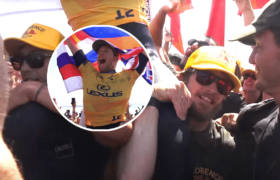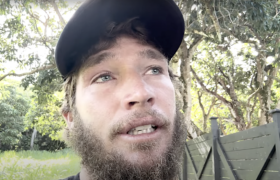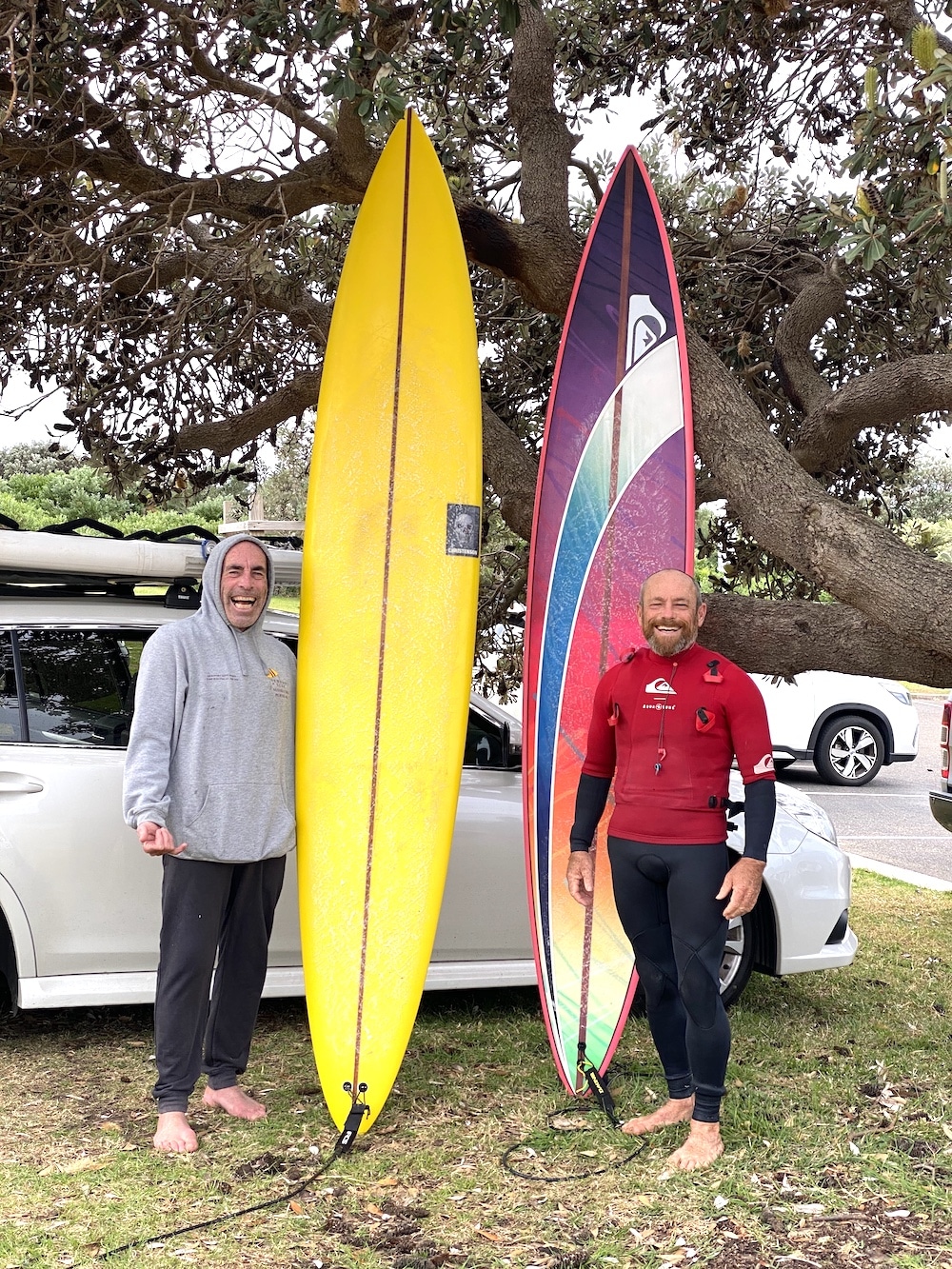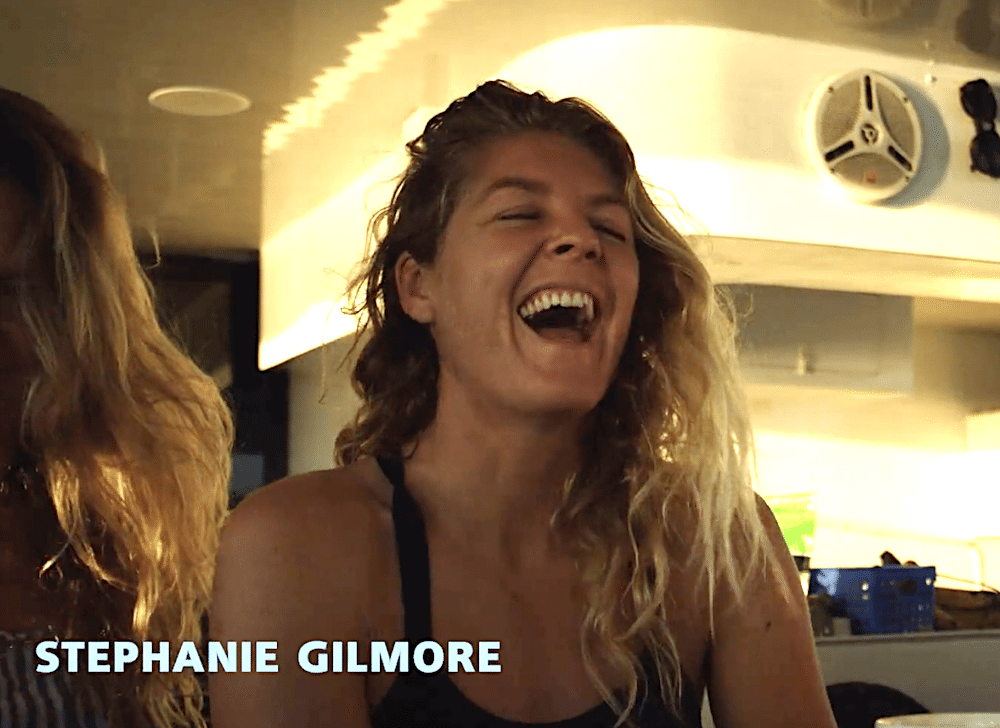The making of Little Sister and the wrangling of rhinos…
You break a board, you get another, right?
I broke my 9’6” Rawson gun in June 2016 on a freak day at my home beach.
The board had lasted 28 years, one of a quiver of three from 1988: shaped by Pat, glassed by Jack Reeves, sanded by Charlie Walker, the greatest trio of boardmakers in history or ever.
It’d pinballed off all the rocks down Waimea Point and survived. Caught 25 foot waves and been mauled by Bay closeouts and survived. Traveled back to Oz in 2010 without a board bag, and survived that without a scratch.
Now it was on the sand at Newport Beach, Australia, shorn in two by the biggest long interval groundswell to hit the area in a generation. I’d swum in from the place that broke it, looking in to the beach, where a mate was walking along the shoreline, this board and all its deep memory in two pieces under his arm.
So I gotta replace it. I gotta go Modern.
I waited a while, thought about it. What did I want?
My thoughts strayed to Greg Long, and to the shaper who’d dialed his Eddie winning quiver from 2009, San Clemente’s Chris Christenson. It took a full year for my thoughts to stray this way. This is how my surfing brain works now, like the other parts of my brain. In the 28 years of owning the Rawson, I’d grown calmer, less reactive, possibly less likely to make the kinds of dumb decisions that’d been such a significant feature of my surfing life. There was less froth, but when there was froth, it was thick and fucken deep.
Just as well, because it took another 18 months to get this board.
Everything about it, the way it was made, the design ideas behind it, the fin set-up, the glassing process, even down to the way it eventually sat in the water and slid into a wave, was an expression of how much has changed in that old Rawson’s lifespan.
Chris does some boards in Australia via the Onboard shop in Mona Vale, about four k’s from my house. The way it works, people order boards, Chris sends files, the boards are cut, then Chris flies in once a year and spends a manic week or so finish-shaping the rough cuts. The time-honoured cycle of the traveling gypsy shaper, accelerated by the advent of Shape3D and the cutter.
I emailed Chris and he was all, yep, let’s do this, and a few ideas were chucked around. That was September 2017. Over a year passed. I would go into the Onboard shop every now and then and lurk over to this dark corner where several stock Christensons were slotted. Not being of the Fish persuasion, I would drag out these three mini round pins, boards Chris later model labeled the Carrera. To call them “step-ups” seemed lame. They were boards for the kinds of waves you might ride a dozen times in your life.
In October 2018 Chris came back with the news that he’d be in town in November and now was the Time. He mentioned a Twiggy Baker model file, 9’8” x 201/2” x 35/8”, Burford blank with a 1/4” Australian red cedar stringer, boom.
It was now an international operation. The blank and cutter were in Australia, the shaper was in California, and the file was in Twiggy’s computer in South Africa. Twig scaled the base file for the board down from 10’8” to 9’8” and sent the file to Australia.
In mid-November, Chris got to town only to find Twiggy’s file had already locked. This happens with custom designed files to prevent copying. You can’t cut from a locked file. At that very moment Twiggy was en route to Nazare for one of the WSL’s big wave CTs. What the fuck? I thought, is this board going to dodge me for another year?
Twig got the ensuing emails the day before he surfed, and re-sent the file. He then won the contest. I emailed him: “Yeah Twig! Shaping boards through time zones one day, winning contests the next!” He hit back: “Your board is the sister of the file I was riding.”
So there was the board’s name, Little Sister.

I spent an hour or so with Christenson while he finish-shaped the blank. Designers, especially good ones, come in a few different varieties. There’s conversationalists, there’s grumpy, there’s serene majesties, there’s the under-appreciated genius. Chris is a skill guy. He was just about to head back to North America for some kind of helicopter snow rescue course. He doesn’t waste words, or foam. I liked this. We talked about various things, while he did a bit of dusting off, and I gazed at the board.

You can look at other people’s boards, but you’ll never look at them like you look at your own. Immediately I saw the radical gulf between the old big wave gun style and the modern version. The old style was drawn-out, flat decked and flat bottomed, reliant on long tail vee, square hard cut Diffenderfer type rails, and raw rocker. That was the Rawson. It was designed to be paddled in flat and driven down the face like a bus, then tipped on to the tail vee and outline curve to drive clear.
Little Sister was a mile away from that: thicker in the core, yet foiled away in all directions, the deck doming down into the rail, with real rocker and a vee that moved with the foil. The effect was that of balance, but around no fixed point — gyroscopic in a way. A board designed to tip on to the rail from the start. On my first surf, a few months later all by myself in big windy early winter waves, I was taken aback by how difficult it was just to paddle. Little Sister swayed around under me, refusing to settle, testing all my paddler’s core strength. At times she felt like she wanted me to tip her onto one of the vee panels and paddle crabwise, rail down. It took me the whole surf to shake off the feeling and locate her best paddling point — quite a way up, a tiny bit forward of the thickest point, where the vee and the curve had a moment of stillness.

But on a wave. Something else.
Second surf was in solid ten-to-fifteen semi-draining reef rights and she went in like butter, straight on to the rail, on an angle, ready to turn. Unlike the old gun, the modern gun likes to be under the lip, the steeper and curvier the better. When I watched Twig in that unearthly first men’s heat at Peahi in 2018 — watched that 50-foot double-up on which he set a rail directly into the barrel from the drop — I realized what these super-board designers have done with these changes: they’ve turned the gun into a tube-rider. The modern gun’s not a gun any more, it’s a knife.
Anyway. Chris had detailed instructions for the glasser, specially concerning the back quad set boxes. Some glassers, he said, had been setting them incorrectly, so that the back set was canted a tiny bit more than the front set. “If that happens, let me know and I’ll make them re-set it,” he said sternly. Also the stringer. Red cedar is a sappier stringer than American spruce, which makes it a nicer flex — unless you leave the cut blank un-glassed too long, and let it dry out. Almost the last thing Chris said to me was, “Don’t let ‘em leave it long.”
Thus the Little Sister disappeared into glassing, and stayed there for three and a half months.
It was with Rhino Glassing in Brookvale, renowned for their immaculate super quality work, yet also seemingly trying to glass half of Sydney’s stock product in the middle of the summer rush. When that shit is going down, ten CI 5’11”s are going to slip ahead of a triple-six custom super-board any day of the week.
I knew this but I could not forget Little Sister. Where WAS SHE? Hidden under a pile of faux-retro longboards destined for some cheesecloth surf shop in Bondi? I niggled Juan, Rhino’s owner, in mosquito-like fashion, while he politely reassured me. “How’s she going?” “Got the deck on yet?” Sting sting sting.
It got awkward.
I could tell Juan was getting the shits with me, but I was getting the shits with him, or at least with this process. Finally I squared up with him, told him the Truth. I’m running on borrowed time, in a way. I’m not who I was when that Rawson quiver was made — 27-years-old, full of god knows what, not even thinking about the march of Time. That luxury, or whatever you want to call it, is in the past. What I know today is what I shoulda known then — that there is no Time.
So finally, Juan called and said he’d be at Onboard with Little Sister next day, and indeed he and she was.
Little Sister is a deep butter yellow. She weighs around eight and a quarter kilos and has double leash plugs. She has a five box Futures set up which thankfully is set clean, so Chris doesn’t have to tell anyone off about the back quad set. She wears an improbably small Lopez tow quad set made of G10 glass by Soar fins, which is a fin company run by an old friend of mine named Greg Trotter, who CAD cuts what I suspect are the best surfboard fins in the world. As far as I can tell, on current evidence she’s one of the top three surfboards I’ve ever had.
I won’t need this board for twenty-eight years.
I’ll be lucky if I need it for fifteen.
Little Sister is it.
She’s the board I’ll catch my last really big wave on.
She might still get me the best wave of my life.
Unless she breaks, she’ll be in the garage when I die.
(Read about Nick’s adventures during Sydney’s washpot May 2020 swell here.)







